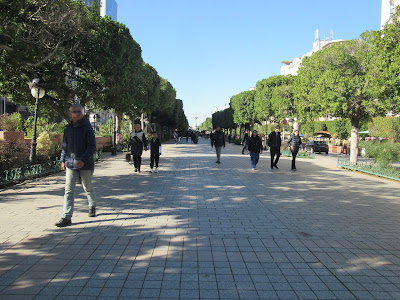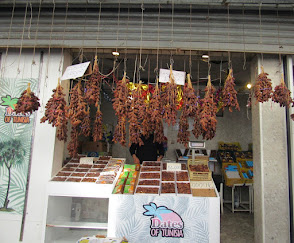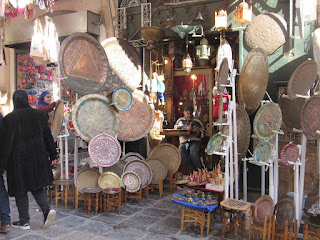
At the eastern end of Avenue Habib Bourguiba is the 125 foot-high clock tower with a gilt-top. Built to commemorate former President Ben Ali’s inauguration on November 7, 1987, the tower is part obelisk, part mid-century-style lampshade. Its lattice screen is illuminated from within at night.

This stunning walkway on Avenue Habib Bourguiba is a leftover of French colonial rule (1881-1956) where the center city saw rapid redevelopment with new boulevards and neighborhoods, the influx of a substantial number of European immigrants, construction of a water supply, natural gas and electricity networks, public transport services, and other public infrastructure. The Avenue de France was modeled after the Champs Élysée of Paris with its trees and broad walkways. It was re-named Avenue Habib Bourguiba after independence in 1956.
This walkway is the same one where the Arab Spring took place for an intensive campaign of civil resistance December 17, 2010 – January 14, 2011. It led to the ousting of 23-year-long dictator Zine El Abidine Ben Ali who officially resigned after fleeing to Saudi Arabia. The rebellion eventually led to a thorough democratization of the country and to free, democratic elections. The demonstrations were caused by high unemployment, food inflation, corruption, a lack of political freedoms, and poor living conditions. The protests resulted in scores of deaths and injuries, most of which were imposed by police and security forces.
I had learned in graduate school that Emile Durkheim of the 19th century was the father of sociology. He was French, and he wrote the book: Suicide. Now how did my professors overlook this 13th century Arab genius? Anas, our guide, said that it's all about propaganda of the dominant Western cultures. Unfortunately, we overlook the contributions of the Arab cultures.
As Westerners, we are very proud of our accomplishments, and we identify with our guys. However, we often fail to see the bigger, more global picture of other cultures' contributions. The question is: how do we narrow this gap and acknowledge other cultures' contributions to humanity and its knowledge? The short answer is travel.
By traveling the world we learn about other cultures and civilizations. This thought is emotional for me because I always knew I wanted to travel; the true meaning of travel is learning about other cultures. Travel opens us to greater possibilities and understandings. We learn more about our world as we see how others have learned to live in theirs. Geography influences a culture's particular solutions for living in that particular place, and it is expressed through its arts, science, politics, economics, agriculture, etc. I discovered that even at a young age I was on the right track for desiring to travel the world, and the Kellogg Fellowship (1984-87) opened the door for me to do it. I still thirst to see and experience more than the 46 countries I've visited.
I'm
here in Tunisia because I wanted to visit another Muslim country that's
not in the Middle East. (It's too dangerous there.) I also wanted to
visit another Maghreb country that attracted French artists, particularly Delacroix and St. Exupéry. Today, many immigrants to France are from the Maghreb so this area is important to understand. Nevertheless, I had to
remind myself that the Arabs influenced this part of the world over 700
years ago more than the French who colonized Tunisia in 1881 until
1956.

Our first group photo on Avenue Habib Bourguiba in Tunis, capital of Tunisia

The French influence in Tunisia is far more limited than I expected. After all, the Arabs had been here since the 7th century. Before them were the Berbers, native people who descended from the Stone Age. The French established a protectorate (i.e., colonialism) from 1881 to 1956. Nevertheless, they did leave behind some things like the French language and certain public buildings like the theatre (above), this arcade, St. Vincent de Paul Cathedral, and an old out-dated street sign.

Medina
 Medina vendors take special care to display their products. I particularly loved the spice displays as shown here.The medina is a very colorful place with everything for sale and sellers who will pull you into their shop if you look like a tourist or someone who shows the slightest interest in the products. It was thus a bit difficult for me to take photos.
Medina vendors take special care to display their products. I particularly loved the spice displays as shown here.The medina is a very colorful place with everything for sale and sellers who will pull you into their shop if you look like a tourist or someone who shows the slightest interest in the products. It was thus a bit difficult for me to take photos.


 Today, there are about 30,700 Catholics living in Tunisia, a predominantly Islamic country, and St. Vincent de Paul is the only active Catholic church. It is located on what used to be called the Avenue de France where the French constructed other European-style buildings during the colonial period. The Cathedral was completed in 1897, as was Saint Louis Church in Carthage, which is no longer functioning. The Cathedral's domes atop its two towers look amazingly like the Sacré Cœur dome of Paris, which was built around the same time.
Today, there are about 30,700 Catholics living in Tunisia, a predominantly Islamic country, and St. Vincent de Paul is the only active Catholic church. It is located on what used to be called the Avenue de France where the French constructed other European-style buildings during the colonial period. The Cathedral was completed in 1897, as was Saint Louis Church in Carthage, which is no longer functioning. The Cathedral's domes atop its two towers look amazingly like the Sacré Cœur dome of Paris, which was built around the same time. 
This cross is named the "Cross of Sbeïtla" because it was found in a Christian basilica there. Given this mosaic's form, liveliness, and colors this cross was probably made during the Byzantine era, which would date it around the 6th century.
 Saint Louis IX of France died in Tunis on August 25, 1270, during an epidemic of dysentery that swept through his army. He was en route from the Eighth Crusade in Jerusalem. He is the only French king who was canonized. He reputedly brought back the "Crown of Thorns" from the Holy Land and the Black Madonna while passing through Egypt. After his death, his heart and intestines were conveyed for burial in the Cathedral of Monreale near Palermo. Besides this reliquary in Tunis, there is also a reliquary of his remains at the Basilica of Saint Dominic, Bologna, Italy.
Saint Louis IX of France died in Tunis on August 25, 1270, during an epidemic of dysentery that swept through his army. He was en route from the Eighth Crusade in Jerusalem. He is the only French king who was canonized. He reputedly brought back the "Crown of Thorns" from the Holy Land and the Black Madonna while passing through Egypt. After his death, his heart and intestines were conveyed for burial in the Cathedral of Monreale near Palermo. Besides this reliquary in Tunis, there is also a reliquary of his remains at the Basilica of Saint Dominic, Bologna, Italy. Saint Cyprian was born in Carthage in 210 to a rich pagan family. He was baptized in 245 and later became a bishop during the siege of Carthage. He was exiled in 257 and decapitated on September 14, 258, in the presence of his clergy and the faithful. Several sanctuaries in Carthage were dedicated to him because he was one of the most dignified bishops in the African Church as well as one of its greatest writers. His chief work includes correspondence that revealed his soul as an apostle and martyr. He is also known as holding an important conference in 256 for 80 bishops of Africa. As bishop, he is known for his profound spirituality, which was inspired by the Scriptures and for his writings that showed his incontestable literary talent.
Saint Cyprian was born in Carthage in 210 to a rich pagan family. He was baptized in 245 and later became a bishop during the siege of Carthage. He was exiled in 257 and decapitated on September 14, 258, in the presence of his clergy and the faithful. Several sanctuaries in Carthage were dedicated to him because he was one of the most dignified bishops in the African Church as well as one of its greatest writers. His chief work includes correspondence that revealed his soul as an apostle and martyr. He is also known as holding an important conference in 256 for 80 bishops of Africa. As bishop, he is known for his profound spirituality, which was inspired by the Scriptures and for his writings that showed his incontestable literary talent. We had our Welcome Dinner at Dar El Jeld, which is in the medina. The building was formerly a palace of
a Tunisian leader.
We had our Welcome Dinner at Dar El Jeld, which is in the medina. The building was formerly a palace of
a Tunisian leader. 













































